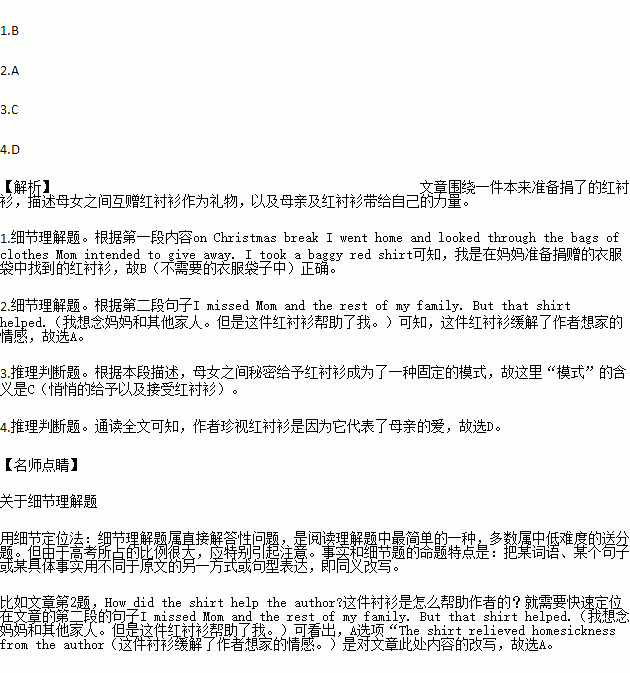题目内容
When I was a freshman, on Christmas break I went home and looked through the bags of clothes Mom intended to give away. I took a baggy red shirt, for I needed something to wear in art class. Mom was surprised. She wore that when she was pregnant with my younger brother.
The red shirt became a part of my college wardrobe. After graduation, I wore the shirt the day I moved into my new apartment and on Saturday morning when I cleaned. When I became pregnant, I wore the red shirt during big-belly days. I missed Mom and the rest of my family. But that shirt helped. I smiled, remembering that Mother had worn it when she was pregnant, 15 years earlier. That Christmas, thinking of the warm feelings the shirt had given me, I wrapped it in holiday paper and sent it to Mom. When Mom wrote to thank me for her “real” gift, she said the red shirt was lovely. She never mentioned it again. The next year, when my husband and I moved the kitchen table, I noticed something red taped to its bottom. It was the shirt! And so the pattern was set.
On our next visit home, I secretly placed the shirt under Mom and Dad’s mattress. Two years passed before I discovered it under the base of our living-room floor lamp. The red shirt was just what I needed now while refinishing furniture. The walnut stains added character.
Years later, my husband and I divorced. With my three children, I prepared to move back to Illinois, depressed. Suddenly I saw the stained red shirt. I smiled. After unpacking in our new home I visited her, and I hid it in her bottom dresser drawer. Meanwhile, I found a good job at a radio station. A year later I discovered the red shirt hidden in a rag bag in my cleaning closet. The shirt was Mother’s final gift. Mother died three months later.
I was tempted to send the red shirt, faded but in decent shape, with her to her grave. But I’m glad I didn’t, my older daughter is in college now, majoring in art. And every art student needs a baggy red shirt to wear to art class.
1.Where did the author get the shirt for the first time?
A. In art class in college. B. In unwanted bags of clothes.
C. In her college wardrobe. D. In the kitchen.
2.How did the shirt help the author?
A. The shirt relieved homesickness from the author.
B. The shirt made her find a good job at a radio station.
C. The shirt was the only clothes that the author had for art class.
D. The shirt was the cheapest gift to give to her Mom tor Christmas.
3.What does the underlined phrase “the pattern” refer to in the text?
A. Visiting the parents regularly.
B. Moving the kitchen table regularly.
C. Secretly giving and receiving the shirt.
D. Often tapping something to the bottom of the table.
4.What is the important reason for the author’s valuing the shirt so much?
A. That her daughter needs it in art class.
B. That it is from her dead Mom.
C. That it is still in decent shape though faded.
D. That it symbolizes mother’s love.
 天天向上一本好卷系列答案
天天向上一本好卷系列答案 小学生10分钟应用题系列答案
小学生10分钟应用题系列答案

 ch he called Galatea was 3. beautiful that he immediately fell in love with it. He begged the goddess Aphrodite to breathe life into the statue and make 4. (she) his own. Aphrodite granted Pygmalion his wish. 5. statue came to life and the couple married and lived happily ever after.
ch he called Galatea was 3. beautiful that he immediately fell in love with it. He begged the goddess Aphrodite to breathe life into the statue and make 4. (she) his own. Aphrodite granted Pygmalion his wish. 5. statue came to life and the couple married and lived happily ever after.